<<PREVIOUS -
HOME -
CONTENTS -
NEXT>> -
![]()
<<PREVIOUS -
HOME -
CONTENTS -
NEXT>> -
![]()
Imaging the Sky Conference 2012
Intel HF3 Auditorium 5200 NE Elam Young Parkway Hillsboro, OR 97124 USA Updated on May 3, 2012 |
|
|
|
||
|
||
|
|
|
|
|
|
|
|
|
|
|
|
|
|
|
|
|
|
|
|
|
|
|
|
|
Sunday May 6, 2012 |
||
|
|
|
|
|
|
|
|
|
|
|
|
|
|
|
|
|
|
|
|

Richard Berry is an author, editor, and software programmer focused primarily on amateur astronomy. His books include a classic, Build Your Own Telescope, a popular introduction to observing, Discover the Stars, the acclaimed manual for big Dobs, The Dobsonian Telescope (with David Kriege), and the book best known to NEAIC attendees, The Handbook of Astronomical Image Processing (with Jim Burnell), which includes the Astronomical Image Processing for Windows (AIP4Win) software widely used for image processing as well as both photometry and astrometry. At age 13, Richard built his first telescope (a 6-inch f/7 Newtonian) and moved on to construct an 8-inch f/10 planetary telescope, a 6-inch RFT, a 12-inch f/7 Newtonian, and an 8-inch Dall-Kirkham Cassegrain. He observed all of the planets, most of the Messier objects, and made deep inroads into the NGC catalog. In those distant days of darkroom chemistry and bromide paper, he specialized in lunar and planetary astrophotography. After majoring in astronomy for his B.A. degree, Richard went on to present a thesis on photoelectric photometry earning an M.Sc. in astronomy. In the technology world, he has designed rocket payload instrumentation, measured air pollution (ozone and hydrogen sulfide) using a laser beam, and tested key components for the Ultraviolet Absorption experiment (MA-059) flown aboard the Apollo-Soyuz Test Project. Switching from technology to editing, Richard served a ASTRONOMY magazine's Technical Editor, then Editor, and finally Editor-in-Chief, for sixteen years, and played a key role in building the fledgling magazine's circulation from 38,000 in 1976 to its peak at 252,000 in 1988. During his years at ASTRONOMY, Richard built a strong, effective, and knowledgeable editorial staff, and worked tirelessly to ensure that manufacturers present only honest and accurate claims in their advertisements. During his years at ASTRONOMY, Richard founded and edited Telescope Making, a quarterly magazine devoted to the community of amateur telescope makers. From 1978 through 1991,Telescope Making introduced its readership to the Dobsonian telescope, the Poncet platform, tilted-component telescopes, and many examples of outstanding amateur observatories.
From 1992 to the present, Richard has written and coauthored a string of books about telescope making, imaging with CCD cameras, and image processing. He has given countless talks and participated in workshops at conferences around the world. His current book, due out this summer or fall, is a comprehensive ray-trace analysis of the telescope, eyepiece, and astrographic camera designs available to today's amateur astronomer.
|
|
|
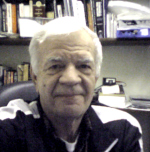
Joe became interested in astronomy while in gradeschool, seeing the moon through a telescope he was hooked. He purchased an Edmund’s 3" reflector while in Jr. High and built an 8" Newtonian in highschool. He received a B.A. in Physics and worked on the Skylab Program for 5 years in Denver. In 1973 he and his wife move to Eastern Oregon. It took 2 decades before he was able to build the observatory of his dreams. As an amateur astronomer, Joe’s primary interest is in science. So far he has posted 38 exo-planet transits to the TRESCA database, viewed four dozen asteroid occultation events, measured three dozen asteroid rotation periods. While participating in a Pro-Am campaign looking for possible exo-planet transits of white dwarf stars, he discovered an un-catalogued eclipsing binary. Joe enjoys traveling to exotic places nearly as much as astronomy. Among his passport visas are India, Libya Egypt and Russia. |
|
|
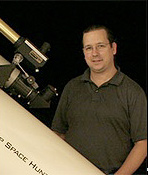
Neil Heacock is an IT professional who moved out of the city for the first time in 2003. After living in LA, Seattle and Portland, he moved to somewhat more rural area of Clark County and really saw the stars. This birthed a strong interest in astronomy which has continued to grow and develop ever since. In 2006 Neil began to dabble in astrophotography and after attending the 2007 Northwest Astrophotography Conference his imaging stared a path to maturity. Neil is still an avid visual observer but with such amazing and easy to use imaging systems available he now images with one setup while observing with another. He runs the Yahoo DSLR Astro Image Processing group with 350+ members and mentors other astrophotographers both local and afar. |
|
|

Tim became a visual variable star observer and joined the AAVSO in 2001. Following an introduction to astrophotography in 2003, he expanded his interest, equipment and skills to become a widely recognized premier CCD variable star observer serving both as a photometry mentor for AAVSO members and an active member of the AAVSO chart team. Tim has reported more than 100,000 photometric observations from CCD images to the AAVSO as of December, 2009. He is also an accomplished author of numerous articles in both amateur and professional astronomy publications, and boasts an impressive meteorite collection. |
|
|
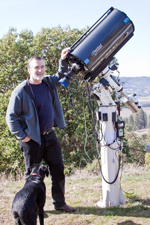
Sean Curry lives in the beautiful Wagner Valley in Southern Oregon. He got his first telescope upon moving there in 2002, and began imaging with a modified DSLR in 2006. Sean has recently upgraded his equipment to include an AP900 Mount, a Tak FSQ106, and a QSI 583wsg camera. He was also fortunate enough to receive his new PlaneWave CDK 12.5 this year, and is beginning to get a handle on longer focal length imaging. Sean supports his astronomy hobby as a Lecturer in GIS at Southern Oregon University, and as a researcher at the University of the Pacific. |
|
|

Duncan Kitchin has been taking astro images since 2003, starting with a
point and shoot digital camera. Since 2005, he has been capturing deep sky
images with a modified DSLR and various telescopes, switching more recently
to a dedicated CCD camera. His current interests include capturing
narrowband images from his back yard in heavily light polluted Beaverton. |
|
|
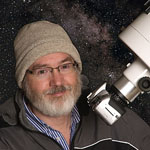
Greg Marshall has been an amateur photographer for some 40 years and started doing astro-photography in 2005. His professional career as an electronics engineer has mostly been involved with image capture, processing and printing. Now retired, he spends his free time capturing and processing images from his home observatory. |
|
|

Miguel Casa was born in Barcelona, Spain & came to the US in 1997. Miguel was introduced to photography & astrophotography by his father. Miguel is a member of ASTER (Astronomy Club in Barcelona, Spain) and is a member of Rose City Astronomers (Portland, OR). He has been doing urban astrophotography for almost 4 years. |
|
|
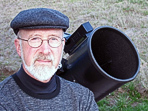
Ken Hose
Ken Hose has been active in visual astronomy for the last 10 years or so. He now has an observatory and taken up astro-imaging. As an engineer, he has an interest in the scientific aspects of the hobby and has a special interest in detecting exoplanet transits. |
|
|
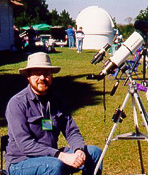
David Haworth enjoys astronomy imaging and processing those images to bring out details that cannot be seen easily by visual observing with the same size optics. David Haworth started astroimaging with a Cookbook CCD camera he built in 1996 and since then has used many types of cameras to image the sky. David wrote Chapter 2: "Afocal Photography with Digital Cameras" in the second edition of "The Art and Science of CCD Astronomy" which was published in December 2005. David's images have appeared in magazine front covers, articles, books, catalogs, videos, music CD covers, T-shirts, other web sites, etc. |